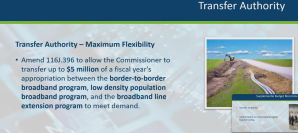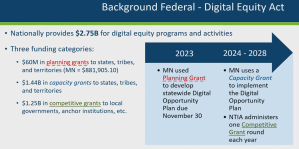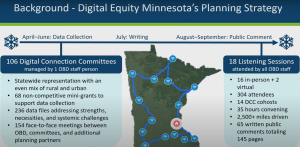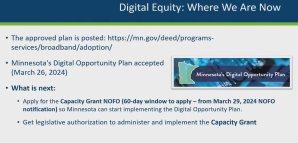Here’s the latest from the NTIA (spoiler alert, looks like Minnesota could get $12 million in digital equity funding)…
The Department of Commerce’s National Telecommunications and Information Administration (NTIA) today announced approximately $811 million in digital equity funding, including allocations for all 56 states and territories and funding available for Native entities. This funding will empower individuals and communities with the tools, skills, and opportunities to benefit from meaningful access to high-speed Internet service.
This funding from the Digital Equity Act in President Biden’s Bipartisan Infrastructure Law is part of the “Internet for All” initiative, a key component of President Biden’s “Investing in America” agenda.
Under the Notice of Funding Opportunity (NOFO) released today, states and territories can apply for funding from President Biden’s Bipartisan Infrastructure Law to begin implementation of their digital equity plans. These digital equity plans identify the barriers to accessing and using digital resources and establish measurable objectives for promoting access to and meaningful use of broadband technology and advancing digital skills.
“President Biden is committed to ensuring everyone in America has access to affordable, reliable high-speed Internet service,” said U.S. Secretary of Commerce Gina Raimondo. “Commerce’s work building high-speed Internet infrastructure is only part of the equation. Families across America need the tools and skills required to make the most of that Internet connection, and that’s the opportunity we’re announcing today. President Biden’s digital equity initiative will make the promise of the Internet come alive for everyone in our country, no matter where they live or what their background is.”
“Today’s announcement marks our nation’s single largest investment in digital equity ever,” said Assistant Secretary of Commerce for Communication and Information and NTIA Administrator Alan Davidson. “This funding will ensure that our seniors, veterans, communities of color, families living below the poverty line, and people living in rural areas have the tools, skills, and devices they need to thrive in the modern digital economy.”
The Internet for All initiative includes three pillars: deployment, equity and affordability. As the Administration moves forward with this vital equity program, President Biden continues to call on Congress to pass legislation that would extend funding for the Affordable Connectivity Program, so tens of millions of households can continue to access this essential program, which enables them to participate in school and access job opportunities, telemedicine, connection with loved ones and more.
Digital Equity Funding Timeline
As part of the Bipartisan Infrastructure Law, the Digital Equity Act provided $2.75 billion to establish three grant programs that promote digital equity and inclusion.
Today’s Notice of Funding Opportunity announces the first funding available through the $1.44 billion Digital Equity Capacity Grant Program. This funding opportunity includes funds appropriated for Fiscal Years 2022-2024. Additional funding opportunities will be available in the future.
In 2022, NTIA began awarding $60 million to states and territories from the State Digital Equity Planning Grant Program. Since then, all 50 States, D.C., and Puerto Rico have submitted their Digital Equity Plans to NTIA for acceptance, and NTIA continues to review plans. Once an eligible entity’s plan is accepted, it is able to apply to this new funding opportunity announced today.
In the coming months, NTIA will launch the Digital Equity Competitive Grant Program, which is a $1.25 billion grant program that will make funds available to a variety of entities, including for example, some political subdivisions of states, native entities, nonprofits, community anchor institutions, local educational agencies, workforce development organizations, as well as territories. By statute, the competitive grant program will launch 30 days after NTIA makes its first Capacity Grant Program award.
Funding Overview for the State Capacity Grant Program
About $760 million is available to 50 states, D.C., and Puerto Rico
Each state’s funding allocation, including the District of Columbia and Puerto Rico, was calculated based on a formula defined in the Bipartisan Infrastructure Law and specified in the Notice of Funding Opportunity. The formula takes into account the relative population of the state (50%), the relative size of the covered populations residing in the state (25%), and the comparative lack of availability and adoption of broadband (25%).
About $45 million is available to Native entities:
The Capacity Grant program will make $45 million available on a competitive basis to Native entities to promote digital inclusion and broadband adoption efforts for their communities. This includes over $3 million for digital equity planning activities and $42 million for related projects. The Digital Equity Act requires that no less than 5% of award funds be available to Tribal governments and Native entities.
About $8.4 million is available to territories:
The Digital Equity Act includes a set aside of no less than 1% of available award funds for the remaining territories: American Samoa, Commonwealth of Northern Mariana Islands, Guam, and U.S. Virgin Islands. This NOFO includes a set aside of $8.4 million, split equally among those four territories.
| State |
Digital Equity Tentative Allocation Amount |
| Alabama |
$13,702,566.00 |
| Alaska |
$5,631,769.64 |
| Arizona |
$16,170,760.44 |
| Arkansas |
$10,161,429.01 |
| California |
$70,226,453.82 |
| Colorado |
$12,368,261.03 |
| Connecticut |
$9,183,114.07 |
| Delaware |
$4,816,482.10 |
| District of Columbia |
$3,804,000.00 |
| Florida |
$41,748,794.74 |
| Georgia |
$22,455,639.68 |
| Hawaii |
$6,017,160.03 |
| Idaho |
$6,305,226.45 |
| Illinois |
$23,732,912.78 |
| Indiana |
$15,096,770.19 |
| Iowa |
$8,442,129.37 |
| Kansas |
$8,229,246.17 |
| Kentucky |
$12,123,531.39 |
| Louisiana |
$12,727,887.98 |
| Maine |
$5,784,349.60 |
| Maryland |
$13,427,134.17 |
| Massachusetts |
$14,133,924.00 |
| Michigan |
$20,585,775.60 |
| Minnesota |
$12,033,288.01 |
| Mississippi |
$10,752,090.73 |
| Missouri |
$14,237,940.09 |
| Montana |
$6,938,534.64 |
| Nebraska |
$6,500,627.76 |
| Nevada |
$9,200,546.13 |
| New Hampshire |
$4,942,018.62 |
| New Jersey |
$18,094,857.62 |
| New Mexico |
$8,673,975.84 |
| New York |
$36,984,641.81 |
| North Carolina |
$22,456,097.01 |
| North Dakota |
$4,549,772.25 |
| Ohio |
$23,291,991.74 |
| Oklahoma |
$11,233,311.64 |
| Oregon |
$9,947,586.17 |
| Pennsylvania |
$25,508,473.61 |
| Rhode Island |
$4,540,059.53 |
| South Carolina |
$12,846,583.30 |
| South Dakota |
$5,010,234.08 |
| Tennessee |
$15,814,288.00 |
| Texas |
$55,641,147.86 |
| Utah |
$7,795,149.91 |
| Vermont |
$5,299,150.18 |
| Virginia |
$18,330,732.47 |
| Washington |
$15,983,291.58 |
| West Virginia |
$9,011,588.00 |
| Wisconsin |
$13,248,029.83 |
| Wyoming |
$5,251,485.99 |
| American Samoa |
$2,100,000.00 |
| Guam |
$2,100,000.00 |
| Northern Mariana Islands |
$2,100,000.00 |
| Puerto Rico |
$9,807,187.39 |
| U.S. Virgin Islands |
$2,100,000.00 |






